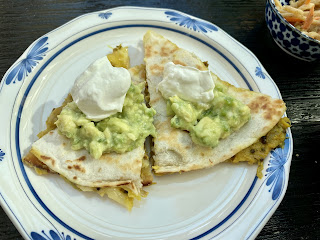Although the package indicated “slices”, the lily bulbs are made of petal-like multiple layers which can come apart especially after blanching (see below). I would have preferred a whole intact bulb since that would have given me more choices in how to prepare it but this will do for sure.
*Digression alert: There is a myth that all lily bulbs are toxic which apparently may be based on the fact that any part of lily is highly toxic to cats (inducing renal failure). Also, the name “lily” is attached to many plants/flowers which are not “true” lily. Some of these certainly would be toxic to humans. In any case, Japanese and Chinese (reportedly also native American Indians) enjoy eating lily bulbs.
I made three dishes; “chawan-mushi” 百合根入り茶碗蒸し(center bottom), bainiku-ae 百合根の梅肉和え (dressed in pickled plum sauce, upper left) and goma-ae 百合根の胡麻和え (dressed in sesame sauce, upper right). I also served lotus root kimpira “renkon-no-kimpira 蓮根のきんぴら(left bottom) and “ohitashi” edible chrysanthemum or “shungiku-no-ohitashi” 春菊のお浸し (right bottom). The fresh lotus root and edible chrysanthemum both came from Weee.
The picture below shows the chawan-mushi made with yuri-ne, topped with ikura salmon roe and blanched sugar snap. You cannot see the yuri-ne well but two are peaking out on either side of the ikura.
The next picture shows the chawan-mushi before the toppings were put on. I put the yuri-ne on the bottom as well as on the top. Other items included fresh shiitake mushroom, and shrimp as usual. The egg and dashi mixture was my usual 1 to 3 ratio. There is no difference in how to make it from standard other chawan-mushi.
For next two dishes, I quickly blanched the yuri-ne, drained it and let it cool before proceeding.
One pickled “umeboshi” plum, meat removed and then chopped fine with a knife, then placed in a Japanese “suri-bachi” mortal, 1/2 tsp mirin added, 1/2 soy sauce and ground to make a smooth paste. I added “kezuri bushi” bonito flakes (the amount arbitrary). I added more bonito flakes on the top.
The below picture shows yuri-ne with sesame dressing.
For sesame dressing:
1tsp white roasted sesame, dry roasted in a dry frying pan and then ground in a suri-bachi
2 tsp white sesame paste or “shiro neri-goma” 白ねりごま
1 tsp rice vinegar
1 tsp sugar
I garnished it with blanched sugar snap
These small dishes were nice and Weee made it possible for me to make these. These were quite filling but we also had a small serving of blue-fine tuna sashimi (frozen Australian from Great Alaska Seafood). The chawan-mushi was particularly special since it brought back good memories of the chawan-mushi my mother used to make.
























































